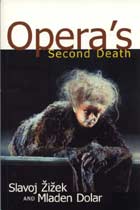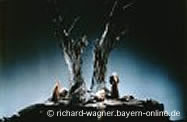In this book, Slavoj Žižek and Mladen Dolar express the wish that some of their love of opera leave traces in their writing. They need not have worried, since one of the pleasures of reading this book is the appreciation of the authors’ passion for opera and, in particular, the works of Mozart and Wagner. Indeed, the book so obviously focuses on these two composers, rather than the genre as a whole, that it makes its title, Opera’s Second Death, a little misleading. For although Dolar has an extended section on the origins of opera, and Žižek’s free-wheeling style brings him, typically, to touch on a number of other composers (as well as writers, filmmakers, and philosophers) their respective focus is Mozart and Wagner.

The “second death” of the book’s title is an allusion to a thesis Lacan elaborates in The Ethics of Psychoanalysis, a thesis that Žižek has himself done much to popularize. Lacan invokes a distinction between natural or biological death, which is part of the cycle of life, and something quite different, a kind of symbolic death, which requires the settling of accounts, the accomplishment of symbolic destiny, the closure of symbolic disharmony (Žižek 135). The meaning of the book’s title remains a little puzzling, however, in the context of a discussion of opera. There is a discussion of the claim that the beginning of the 20th century ought to be seen as the moment of opera’s (first?) death, “at least in its traditional form” (vii). The supporting argument is not entirely convincing, for, as Dolar admits, the genre continues to hold “irresistible appeal” for modern composers and audiences alike. Žižek raises the idea of opera’s “second death,” the “death in peace” which leaves no “symbolic debt,” in the first of his chapters. However, while this theme gets an interesting development and is recurrently elaborated—particularly in relation to the operas of Wagner, specially Tristan and Isolde—it is not followed through in the book in relation to the “second death” of opera.
This aside, Dolar offers a Lacanian reading of Mozart, and Žižek of Wagner, with the two approaches remaining quite different. Dolar develops a tightly argued and very stimulating thesis, whose overarching claim is that each of Mozart’s operas stages a new, and in each case distinct, view about love, marriage, and sexual relations as they appear in the Enlightenment and the emerging bourgeois order. This is an historical analysis of subjectivity, and in particular of the Enlightenment ideal of the autonomous subject in relation to the Other—to put it in Lacanese. He argues that on the one hand Mozart’s operas, as stagings of new, emerging forms of social order, both illustrate and champion the ideals of the Enlightenment and on the other hand they offer a sort of skeptical critique of those same ideals. Dolar covers Mozart’s operas in a more-or-less chronological and narrative fashion. Figaro stages the “point of victory of the Enlightenment” (87), ending with the projection of utopian community and reconciliation. Don Giovanni and Cosi fan tutte “call [the Enlightenment] into question” (87). Don Giovanni offers neither reconciliation nor mercy. The final message of Cosi is that everyone is replaceable, there is no “privileged subjectivity, no privileged object of love” (65) and Dolar quotes Despina to this effect: “One is as good as another because neither is worth a thing” (65). Thus both Giovanni and Cosi point to the problematic side of Enlightenment ideals. Die Zauberflöte, on the other hand, is seen as an attempt to “unite the Enlightenment’s rationalism with everything that seems to oppose it” (81), to “unite mythology and reason” (81). This narrative is summarized by Dolar as a circle. “Figaro is the point of victory of the Enlightenment,” Don Giovanni and Cosi fan tutte call it into question, and Die Zauberflöte “represents the transition to … myth” (87).
The operas that interest Dolar most are the ones that he finds most ambiguous, Don Giovanni and Cosi fan tutte. Dolar is fascinated with the figure of Giovanni and how on one hand he represents the autonomous enlightenment figure yet, by never compromising over his desire, demonstrates the destructive side of pure autonomy or freedom. The ambiguity between freedom and control is apparent in Cosi also and Dolar discusses how the protagonists in the opera are represented as puppets. He extends this with a passage on the Enlightenment fascination with machines and automata.
The second part, by Žižek, is more difficult to sum up. Žižek gives no historical account, but instead offers a recurrent and somewhat insistent treatment of the relationship between death, love, desire, and jouissance. This is best exemplified in his treatment of Tristan, which Žižek returns to again and again, in a recurrent, renewed, and modified repetition. His section begins with an essay on the death drive in Wagner, but it is unclear why this is not linked to subsequent chapters on Wagner. At the beginning of the essay he does refer to the first part of the book, remarking that instead of providing a counterpart to Dolar he will start with Tristan as the “zero-level” work and then read later works of Wagner and other composers as variations on it. This actually contradicts the introduction, however, where it is stated that Žižek’s section culminates in an analysis of Tristan. Žižek’s portion also has an odd “interlude” called “feminine excess”—whose rationale for being in the book seems to be a few references to Kundry. It is possible, though this is speculation on our part, that since one of the currents running through Žižek’s chapters is Wagner’s ambiguous relationship to the feminine and that the interlude is intended to enhance our understanding of Wagner.
Žižek’s chapters one and three are repetitive in places. For instance both speculate on alternative endings to Tristan, and both refer to Brecht’s play Jasager. This repetition does not appear to be deliberate. These are quibbles, really, over passages that a good edit could and should have rectified, and more care might have been made to turn this into a coherently structured book. (A minor but indicative example of this is Dolar’s use of the original language titles of Mozart operas while Žižek gives their English translation.)
The book offers more than just a Lacanian interpretation of Mozart and Wagner, and makes fascinating reading both for opera lovers, whether knowledgeable about Lacan or not. It is nevertheless true to say that the book often assumes a level of familiarity with Lacan. There are places where no attempt has been made to explain Lacanian terminology; we find claims such as, “S1 has to unify with S2: signifier of the master has to unify with the signifier of knowledge” (82), and “where is the Lacanian real here?” In contrast, some fairly basic information is provided about operatic origins, for instance, which would not be necessary for a musicologist. One should stress, however, that not having a background in Lacan rarely detracts from the book’s interest. And although psychoanalysis is a constant reference, so too is Kierkegaard and, to a lesser extent, Hegel, while Žižek frequently refers to Brecht, Kafka, Heidegger, Nietzsche, and Kant, amongst others.
Dolar engages with much of the musicological literature on Mozart, although not the most recent. Žižek engages less with the legion literature on Wagner, with the exception of the work of the Lacanian writer, Michel Poizat. As already mentioned, Žižek has a chapter on the “death drive” in Wagner, two on Tristan, and one that focuses on Parsifal. Tristan however is presented constantly as problematic, in particular the events of Act III. The book fin

ally reaches some sort of conclusion about this act, with Žižek actually agreeing with its interpretation by the French stage director Jean-Pierre Ponnelle. Ponnelle presented Act III in such a way that it became clear that the appearance of Isolde was just an hallucination on Tristan’s part, and that Isolde’s final Liebestod was mere fantasy.
Michel Poizat. As already mentioned, Žižek has a chapter on the “death drive” in Wagner, two on Tristan, and one that focuses on Parsifal. Tristan however is presented constantly as problematic, in particular the events of Act III. The book finally reaches some sort of conclusion about this act, with Žižek actually agreeing with its interpretation by the French stage director Jean-Pierre Ponnelle. Ponnelle presented Act III in such a way that it became clear that the appearance of Isolde was just an hallucination on Tristan’s part, and that Isolde’s final Liebestod was mere fantasy.
It does not much matter that one may not fully understand all the details of the Lacanian analysis, for the book offers such an array of stimulating and provocative ideas on the operas of Mozart and Wagner but also in Žižek’s writing on Rossini, Strauss, and Shostakovitch in paraticular, that it will provide enthralling reading for any opera lover—one is tempted to add, “for any film lover,” given Žižek’s constant reference to film as well. There are also times where Žižek, chiefly because of his use of startling juxtapositions, can be extremely funny; for instance his description of the famous Tristan Act II love duet, with its inarticulate language, “Thou (I) Isolde, Tristan (I) (Thou), no more Tristan, no more Isolde,” as a kind of inversion of the lines from Tarzan “Me not Tarzan, you not Jane” (125). Such things stay in the memory.
Russell Grigg
Deakin University
Works Cited
Žižek, Slavoj. The Sublime Object of Ideology. London: Verso, 1989.
